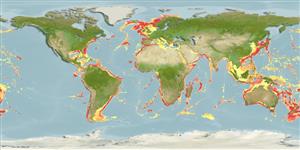分類 / Names
俗名 | 同種異名 | Catalog of Fishes(屬, 種) | ITIS | CoL | WoRMS | Cloffa
Elasmobranchii
板鰓亞綱 (鯊魚與魟魚) (sharks and rays) >
Squaliformes (Sleeper and dogfish sharks)
角鯊目 (Sleeper and dogfish sharks) >
Dalatiidae (Sleeper sharks)
鎧鯊科 (Sleeper sharks)
Etymology: Dalatias: Etymology not explained nor evident. A few online sources suggest Dalatias is derived from dalos (Gr.), torch or firebrand, but nothing in Rafinesque’s description supports this interpretation. Interestingly, D. licha is bioluminescent, a fact that was discovered and resported only recently and was certainly unknown to Rafinesque and other early naturalists. See: Mallefet J., D. W. Stevens, and L. Duchatelet. 2021. Bioluminescence of the largest luminous vertebrate, the kitefin shark, Dalatias licha: first insights and comparative aspects. Frontiers in Marine Science 8 (article 633582): 1-13 (See ETYFish); licha: Latinization of “La Liche” as reported by Broussonet (1780), an old French word for this shark, possibly from from the Occitan lecha or lec, meaning “glutton” (See ETYFish).
More on author: Bonnaterre.
Environment: milieu / climate zone / depth range / distribution range
生態學
海洋 深海底的; 深度上下限 37 - 1800 m (Ref. 247), usually 300 - 600 m (Ref. 247). 深水域; 72°N - 56°S, 98°W - 153°W
Western Atlantic: Georges Bank and northern Gulf of Mexico. Eastern Atlantic: Iceland (Ref. 12462), Scotland, and Irish Atlantic slope to Morocco, western Mediterranean, Madeira to Cameroon. Western Indian Ocean: Mozambique and South Africa. Western Pacific: Japan, Australia, and New Zealand. Central Pacific: Hawaii.
西大西洋: 新英格蘭喬治亞淺灘與墨西哥灣北部。 東大西洋: 冰島 (參考文獻 12462) ,蘇格蘭與愛爾蘭的大西洋斜坡到摩洛哥,地中海西部,馬得拉群島到喀麥隆。 西印度洋: 莫三比克與南非。 西太平洋: 日本,澳洲與紐西蘭。 中太平洋: 夏威夷。
Length at first maturity / 大小 / 重量 / 年齡
Maturity: Lm 139.0, range 117 - 159 cm
Max length : 182 cm TL 雄魚/尚未辨別雌雄; (Ref. 10717)
背棘 (總數) : 0; 臀棘: 0. Moderately sized, short- and blunt-snouted shark with two almost equal-sized dorsal fins; papillose thick lips; small slender-cusped upper teeth and very large lower teeth with erect triangular serrated cusps and distal blades; first dorsal fin on back with its origin behind the pectoral rear tips and its base closer to the pectoral base than the pelvic fins; and caudal fin with the ventral lobe not expanded (Ref. 247). Dark grey-brown to black; trailing edges of fins translucent (Ref. 26346).
中等大小的, 短- 與吻鈍的鯊魚有二幾乎相等的-大小了背鰭; 乳突狀的厚唇; 小的尖端細的上顎齒與非常大的下顎齒有直立的三角形的鋸齒狀的尖頭與末梢部的葉片; 第一背鰭背面有之上它的起點在胸的後頂端與它的基底後面更靠近超過腹鰭的胸鰭基底; 而且尾鰭有不被擴大的腹的葉.(參考文獻 247) 暗灰褐色的到黑色的; 鰭的蔓緣半透明的.(參考文獻 26346)
Found on outer continental and insular shelves and slopes (Ref. 247). Mainly found on or near the bottom but readily occurs well off the substrate (Ref. 247, 58302). Often pelagic (Ref. 58302). Found singly or in small schools (Ref. 6871). Feeds mainly on deepwater bony fish, but also skates, other sharks (etmopterids in Ref. 123656), cephalopods and crustaceans (Ref. 5578). This bioluminescent shark (currently the largest luminous vertebrate) emit light ventrally to counterilluminate which might be used to illuminate the ocean floor while searching/hunting for prey; or to stealthily approach prey, using counterillumination camouflage, before striking fast when it is close enough (Ref. 123656). Ovoviviparous (Ref. 205), with 10-20 young born at 30-42 cm (Ref. 26346). Used for its squalene liver oil, leather and meat, as well as for fishmeal (Ref. 6871).
棲息於大陸棚和島嶼棚外緣與斜坡.。 (參考文獻 247) 主要地發現在底部上面或附近但是輕易地出現相當外海的底部.(參考文獻 247,58302) 時常大洋性的.(參考文獻 58302) 發現獨自或一小群.(參考文獻 6871) 主要吃深水的硬骨魚,也捕食魟魚,其他的鯊魚,頭足類動物與甲殼動物。 (參考文獻 5578) 卵胎生的 (參考文獻 205), 藉由 10- 在 30-42 公分被出生的 20個幼魚.(參考文獻 26346) 用來.它的 squalene 肝油,皮革與肉, 以及用於魚粉.(參考文獻 6871)
Life cycle and mating behavior
成熟度 | 繁殖 | 產卵場 | 卵 | 孕卵數 | 仔魚
Ovoviviparous (Ref. 247). 10-20 young born at 30-42 cm (Ref. 26346); 10-16 young born at 30 cm TL (Ref.58048). Distinct pairing with embrace (Ref. 205).西大西洋: 新英格蘭喬治亞淺灘與墨西哥灣北部。 東大西洋: 冰島 (參考文獻 12462) ,蘇格蘭與愛爾蘭的大西洋斜坡到摩洛哥,地中海西部,馬得拉群島到喀麥隆。 西印度洋: 莫三比克與南非。 西太平洋: 日本,澳洲與紐西蘭。 中太平洋: 夏威夷。
Compagno, L.J.V., 1984. FAO Species Catalogue. Vol. 4. Sharks of the world. An annotated and illustrated catalogue of shark species known to date. Part 1 - Hexanchiformes to Lamniformes. FAO Fish. Synop. 125(4/1):1-249. Rome, FAO. (Ref. 247)
IUCN 瀕危狀態 (Ref. 130435: Version 2024-1)
人類使用
漁業: 低經濟
工具
特別的報告
下載 XML
網路資源
Estimates based on models
Preferred temperature (Ref.
123201): 2.5 - 14.3, mean 5.3 °C (based on 3093 cells).
Phylogenetic diversity index (Ref.
82804): PD
50 = 1.0020 [Uniqueness, from 0.5 = low to 2.0 = high].
Bayesian length-weight: a=0.00240 (0.00181 - 0.00318), b=3.14 (3.06 - 3.22), in cm total length, based on LWR estimates for this species (Ref.
93245).
營養階層 (Ref.
69278): 4.2 ±0.4 se; based on diet studies.
回復力 (Ref.
120179): 低的, 最小族群倍增時間4.5 - 14 年 (Fec=10-20).
Prior r = 0.27, 95% CL = 0.18 - 0.40, Based on 1 data-limited stock assessment.
Fishing Vulnerability (Ref.
59153): High to very high vulnerability (65 of 100).
Climate Vulnerability (Ref.
125649): Moderate vulnerability (38 of 100).
Nutrients (Ref.
124155): Calcium = 6.01 [1.29, 31.29] mg/100g; Iron = 0.325 [0.075, 1.053] mg/100g; Protein = 19.3 [17.4, 21.2] %; Omega3 = 0.303 [0.107, 0.998] g/100g; Selenium = 21.6 [5.9, 65.2] μg/100g; VitaminA = 6.5 [1.4, 30.4] μg/100g; Zinc = 0.214 [0.104, 0.400] mg/100g (wet weight);
